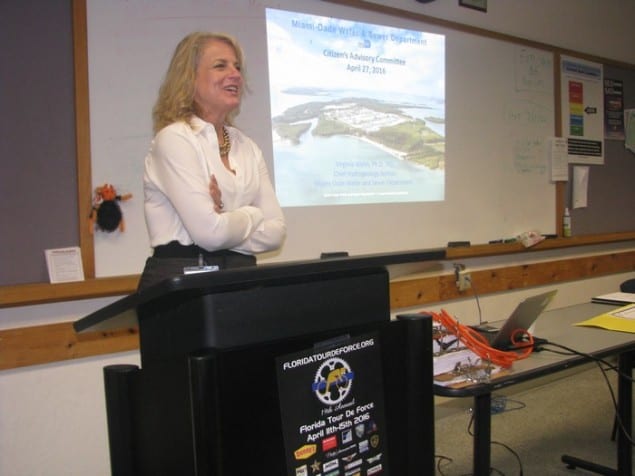
A compatible solution to reduce saltwater intrusion into Florida Power & Light cooling canals at its Turkey Point generating plant may come by May 16, according to a Miami-Dade Water & Sewer Department geologist.
“We’re hoping for a workable plan will result after the state took action on Apr. 25,” Dr. Virginia Walsh, senior professional geologist for Miami-Dade County, told a West Kendall audience on Apr. 27.
She said that only two days previous to her appearance, the Florida State Department of Environmental Protection gave FPL a 21-day notice to propose a plan to clean its canals that have leaked harmful mineral deposits into the Biscayne Aquifer during the past 40 years.
“We’re optimistic that FPL working with the county can come up with a solution to protect the aquifer from intrusion. It’s our main source of drinking water,” said Walsh, who also is involved in a $5.2 billion effort to overhaul Miami-Dade’s long-neglected sewage disposal system.
In a visual presentation, Walsh pointed out two of four wells located west of the Turkey Point generating plant that have shown signs of saltwater intrusion and are being treated to reduce the effects.
The state reported that the 5,900-acre canal network had contributed to the inland spread of saltwater and asked for any FPL studies to plan cleanup efforts.
Walsh’s remarks before the Miami-Dade Police West End District Citizens Advisory Committee meeting described several key issues facing the county water system that furnishes 314 million gallons of water daily for 2.3 million residents.
Walsh singled out a long-term $13.5 billion capital investment plan to begin long overdue replacement of 7,918 miles of slowly deteriorating pipeline and 1,042 pumping stations that keep the system operative today, the largest water and sewer utility in the Southeast United States and fifth in the nation.
A department website forecast that during the next two decades the county investment is expected to create 16,470 new jobs over the next 10 years and generate $24.9 billion in economic output.
Detailing the history of the Biscayne Aquifer, Walsh said a systematic multi-year capital plan has been designed to meet federal and state environmental standards by upgrading pipes, pump stations and water and wastewater treatment plants throughout the system.
Other key points by Walsh:
• The porous lime rock nature of constantly dissolving fossil material of the Biscayne Aquifer rates its “flow as the most prolific in the world;”
• The aquifer is capable of producing up to 473 million gallons of water daily but current demand of MDC water customers (314 million) daily has a permitted ceiling up to 359 million per day to accommodate demand;
• Sea rise is predicted along the Florida southeast coastline of 6-10 inches by 2030; 14-16 inches by 2060; up to 61 inches by 2100 with a potential of 80 inches;
• State banning of Miami-Dade’s treated sewage to ocean outfalls by 2020 has resulted in building injection wells to pump treated sewage to a “Boulder Zone,” 3,000 or more feet underground below the aquifer.
“We are intent on replacing septic tanks that are still used throughout the older residential sections of Miami, i.e. Coral Gables, South Miami and Hialeah” as part of overall capital improvements, she indicated.
The West End District CAC next meets at the District Headquarters, 10000 SW 142 Ave., at 7:30 p.m. Wednesday, May 25.






